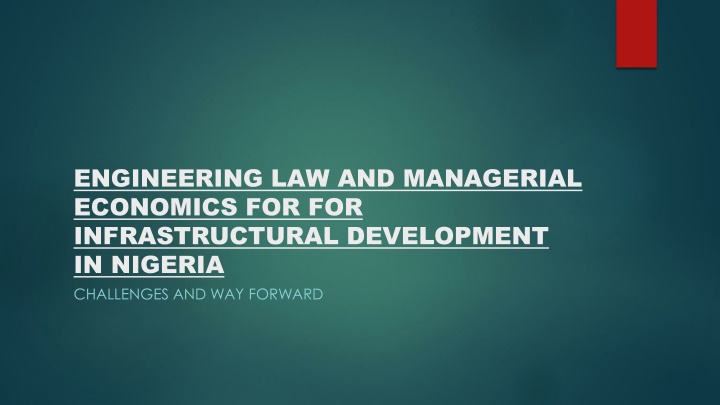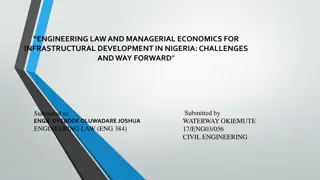ENGINEERING LAW AND MANAGERIAL ECONOMICS FOR FOR INFRASTRUCTURAL DEVELOPMENT IN NIGERIA
Infrastructure development is crucial for democratic governance in Nigeria, but faces challenges such as limited resources, decayed infrastructure, and international standards. Overcoming these hurdles requires strategic planning and continuous research and development.
Download Presentation

Please find below an Image/Link to download the presentation.
The content on the website is provided AS IS for your information and personal use only. It may not be sold, licensed, or shared on other websites without obtaining consent from the author.If you encounter any issues during the download, it is possible that the publisher has removed the file from their server.
You are allowed to download the files provided on this website for personal or commercial use, subject to the condition that they are used lawfully. All files are the property of their respective owners.
The content on the website is provided AS IS for your information and personal use only. It may not be sold, licensed, or shared on other websites without obtaining consent from the author.
E N D
Presentation Transcript
ENGINEERING LAW AND MANAGERIAL ECONOMICS FOR FOR INFRASTRUCTURAL DEVELOPMENT IN NIGERIA CHALLENGES AND WAY FORWARD
Abstract introduction on infrastructure in Nigeria INFRASTRUCTURE DEVELOPMENT IS THE BASIS OF MEASURING THE PERFORMANCE OF DEMOCRATIC LEADERS AND IT IS THE FOUNDATION OF GOOD DEMOCRATIC GOVERNANCE. INFRASTRUCTURE IS THE MEDIUM, THE TOOLS AND TECHNIQUES OF A PROJECT OR PROGRAM OR STRATEGY. DEMAND FOR INFRASTRUCTURAL DEVELOPMENT IS HIGHER AND RESOURCES USED IN PROVISION OF INFRASTRUCTURE ARE LIMITED. ETHNIC-INTEREST AGITATION AND LOBBYING ARE COMMON THINGS IN DEMOCRATIC GOVERNANCE. THE MILITARY ERA IN NIGERIA WAS FOR THE MOST PART OF THE ECONOMIC BOOM AND ONLY SUCCEEDED IN WIDENING THE GAP IN INFRASTRUCTURE DEMAND AND PROVISION. MOST INFRASTRUCTURES ARE NOW DECAYED AND NEED REPAIR OR REPLACEMENT. GOVERNMENT IS THE SYSTEM THAT ORGANIZES AND SENSITIZES THE PEOPLE OF AN AREA IN OTHER FOR ALL TO HAVE AN ACCEPTABLE COMMUNITY. GOVERNMENT HAVE THE POWER TO PUT IN PLACE ALL MEASURES THAT IT DEEMS FIT WILL MAKE AN ENVIRONMENT CONDUCIVE FOR LIVING FOR EVERYBODY. INFRASTRUCTURE DEVELOPMENT IN DEMOCRATIC GOVERNANCE INVOLVES IDENTIFYING THE RIGHT PROJECT, CARRYING OUT FEASIBILITY AND VIABILITY STUDIES AND CARRYING OUT PHYSICAL DEVELOPMENT OF THE PROJECT. THE CHALLENGES ARE NUMEROUS AND INCLUDE FINANCE, TECHNOLOGY FOR DEVELOPMENT, MAINTENANCE AND DESIGN. THE CHALLENGES ALSO INCLUDE INTERNATIONAL REQUIREMENTS OF PROJECT TO BE SUSTAINABLY DEVELOPED. PROJECTS MUST MEET THE CARBON EMISSION STANDARD SET BY INTERNATIONAL ORGANIZATIONS, COMMUNITIES MUST BE BIO-DIVERSIFIED AND EMIT AS LITTLE GREENHOUSE GASES (GHGS) AS POSSIBLE, NATURAL ENVIRONMENT MUST BE PRESERVED AND SO ON. THE CHALLENGES ARE MANY BUT ANY SERIOUS GOVERNMENT CAN OVERCOME THEM AS A RESULT OF INCESSANT RESEARCH AND DEVELOPMENT IN INFRASTRUCTURE DEVELOPMENT WORLDWIDE.
The Challenges of Infrastructure Development in Democratic Governance Infrastructure is the basic physical and organisational structures needed for the operation of a society like industries, buildings, roads, bridges, health services, governance and so on. It is the enterprise or the products, services and facilities necessary for an economy to function. Infrastructure can be described generally as the set of interconnected structural elements that provide framework supporting an entire structure of development. It is the means of achieving an objective or set of objectives and also includes the objectives. It is an important term for judging a country, region or state s and individual s developments/status. The term typically refers to the technical structures that support a society, such as roads, water supply, sewers, electrical national grids, telecommunications, and so forth, and can be defined as "the physical components of interrelated systems providing commodities and services essential to enable, sustain, or enhance societal living conditions"
The installations that form the basis for any operation or Governance can be described as the total ability to organize, synthesize and direct the various Viewed functionally, infrastructure facilitates the production of goods and services, and also the system ". Infrastructure in developing countries connotes roads and transport infrastructures. The actions of the working parts of government machinery in order for such government to perform distribution of finished products to end-users (markets), as well as basic social services such as advent of telecommunication infrastructure in Nigeria brought infrastructure to the front seat as the meaningfully, creditably and acceptably . This explains that governance involves schools and hospitals; for example, roads enable the transport of raw materials to a factory products and services necessary for the performance of an entity. both the leaders and the followers and the process of governance must be democratic, involves There are two types of infrastructure, Hard and Soft" infrastructure. Hard refers to the large (American Heritage Dictionary, 2009). In military parlance, the term refers to the buildings and people to be popular, responsible and allows people s will to reign. physical networks necessary for the functioning of a modern industrial nation, whereas "soft" permanent installations necessary for the support, redeployment, and operation of military forces. Achievements of state leaders are measured with the level and type of infrastructural development infrastructure refers to all the institutions which are required to maintain the economic, health, and the leaders or those in position of authority engage in compared to the agitation of the people and the cultural and social standards of a country, such as the financial system, the education system, the available resources. The obstacles of providing infrastructures in a democratic health system, the governance system, and judiciary system, as well as security setting and the methods of tackling the obstacles are the premise of this paper.
THE NATURE OF INFRASTRUCTURES IN THIRD WORLD COUNTRIES (NIGERIA)
Infrastructuredevelopment is one of the bases of assessing the achievements of democratic leaders and it is the foundation of good democratic governance. Agitation for infrastructural development is higher in democratic government than in military dictatorship or compared to developed countries. This is because the resources for provision of infrastructure are always scarce. Ethnic-interest agitation and lobbying are common things in democratic governance in developing countries. This is why the Office of Government Commerce (OGC) in United Kingdom, advised that infrastructure project initiation should be done by an office specifically established to do this job. The Infrastructural report of Nigeria just like any third world country is nothing to write home about. Most infrastructures are now decayed and need repair, rehabilitation or replacement. Government is the system that plans, organizes, controls and supervises the people who are resident in an area in other for all to have conducive-environment for living and a sense of belonging. Governments have the power to put in place all measures that it deem fit will make an environment beneficial for living for everybody Infrastructure development in democratic governance is more challenging because of the accessibility of people to government and involves identifying the right project, carrying out feasibility and viability studies and embarking out physical development of the project The challenges are numerous and include finance, technology for development, maintenance and design. The challenges also include quality requirements of projects to meet international standard and to be sustainably developed. Projects must meet the carbon emission standard set by international organizations like International Standard Organisation.
THE BENEFITS OF INFRASTRUCTURE IN NATIONAL DEVELOPMENT The linkages between infrastructure and economic growth are multiple and complex. Not only does infrastructure affect production and consumption directly, it also creates many direct and indirect externalities. It also involves large flows of expenditure, thereby creating additional employment. Studies have shown that infrastructure can have a significant impact on output, income, employment, international trade, and quality of life. Infrastructure development can reduce stress and promote good health. It will also reduce crime level. Infrastructure has always played a key role in integrating economies within a region. Well developed and efficient infrastructure is essential for a region's economic development and growth. In a dynamic concept, infrastructure is seen as a regional public good that moves factor of growth. The African Development Bank (ADB) has made infrastructure development a cornerstone in its development agenda with regional member countries (TMSA, 2012). The Bank recognizes that lack of adequate social and economic infrastructure is one of the key constraints to short- and medium-term poverty reduction in Africa, and has thus been a major force in private and public sector infrastructure development through the provision of financial and technical resources. There have been considerable changes in the delivery of national infrastructure services across Africa. While Nigeria has improved its telecommunication infrastructural situation, it has not improved in other areas like health, education, airport infrastructures, electricity, housing and transportation. However, performance in terms of infrastructure service delivery and quality continue to vary across countries. Infrastructure is the medium of production of goods and services and forms the national asset of any nation.
THE CHALLENGES OF INFRASTRUCTURE DEVELOPMENT IN NIGERIA
The challenges of infrastructure development in Nigeria are: Dearth of Visionary Leaders: Capital Flight, Capital Sink and Capital Stagnancy: Demand and supply: Infrastructure development projects in Nigeria suffer from capital flight, capital sink and capital stagnancy. A lot of materials and managerial services are procured outside the country. The contracts are full of loop-holes that allow leakages of funds. In some cases, there are over-design for the designers to earn more professional fees which are percentage of the contract sum. Capital stagnancy due to abandoned projects are also rampant. Due to poor performances of most past leaders in the area of infrastructure provision, the agitation for infrastructure development overwhelms the provision. With a land mass of 9,110,000 square kilometers of land and over 150,000 million people, Nigeria has a total road network of 193,200KM. This comprise of 34,123KM federal roads, 30,500KM state roads and 129,577 KM local government roads. Unfortunately, over 70% of the federal roads are in bad state of repair. In the area of housing, Nigeria requires about 17 million housing units and 60 trillion naira in order to meet its housing needs. Visionary leaders are the builders of a new dawn, working with imagination, insight, and boldness. They present a challenge that calls forth the best in people and brings them together around a shared sense of purpose. Visionary leaders are change agents. Nigeria contains few change agents and therefore lacks the needed infrastructure to develop the nation.
Project Management: Procurement Method : Corruption: Project management approach in project delivery evolved in the late fifties in the United States of America (USA) when it was first used by the American Army for military projects execution. The success recorded through project management approach in the Defense sector led to its establishment as a reliable method of project delivery in other sectors like construction, manufacturing, health Information Technology (IT), media, pharmaceutical, education and entertainment (Oyedele, 2012). The approach was introduced into United Kingdom (UK) in the early sixties. Countries like Hong Kong, Malaysia, Canada and Ireland have adopted this approach, but it is still unpopular in developing countries, especially in Nigeria. Risk management is necessary for all Nigerian projects. The procurement methods being adopted are prone to criticisms. The Public Finance Initiatives, especially the Concession Method and Public/Private Partnership (PPP) are questionable and seems to mortgage others who are not part of the arrangement to the scheme s future. The 105- kilometre Lagos-Ibadan Expressway which, under the PPP scheme, the federal government did concession to Bi-Courtney Consortium in 2009 for N89.53 billion for 25 years is not the best arrangement possible and has not change the situation of the road. Corruption does not only raise the price of infrastructure, it can also reduce the quality of, and economic returns from, infrastructure investment. The corruption in Nigeria is very high and unbearable for effective infrastructural development. The Bureau of Public Procurement (BPP), the Independent Corrupt Practices Commission (ICPC) and Economic and Financial Crimes Commission (EFCC) have not been able to eradicate corruption in the country. The BPP has saved the country a whopping sum of N216.6 billion during the 2010 Appropriation year from its review of contract processes before the issuance of Certificate of No Objection.
CONCLUSION CONCLUSION THE CHALLENGES OF INFRASTRUCTURE DEVELOPMENT IN THIRD WORLD COUNTRIES ARE MANY. THE DEMAND SURPASSES THE SUPPLY AND FINANCE THAT WILL STIMULATE RAPID PROVISION IS NOT THERE. DUE TO WIDE GAP BETWEEN PROVISION AND NEEDS, THE LEADERSHIP CLASSES ARE IN ARREARS IN ALL SECTORS. THE POLITICAL SITUATION IS NOT ENCOURAGING TO FOREIGN INVESTORS. GOVERNMENTS DO NOT SET THE PRIORITY RIGHT IN INFRASTRUCTURE DEVELOPMENT. PROJECTS ARE SUPPOSE TO MEET OBJECTIVES, BUT IN MOST CASES, PROJECTS EMBARKED UPON ARE WHITE ELEPHANT PROJECTS. GOOD GOVERNANCE WILL BE THE ONLY ANTIDOTE THAT CAN BRIDGE THE WIDE GAP. SECONDLY, GOOD GOVERNANCE PROMOTES ACCOUNTABILITY, REDUCES CORRUPTION AND THEREFORE MINIMISES RESOURCE WASTAGE THROUGH INEFFICIENCY. AND FINALLY, GOOD GOVERNANCE ENSURES STABILITY (ECONOMIC AND POLITICAL) AND REDUCES THE LEVEL OF RISK ASSOCIATED WITH LARGE AND LUMPY INFRASTRUCTURE INVESTMENTS. THIS IN TURN FACILITATES THE MOBILIZATION OF BOTH PUBLIC AND PRIVATE SECTOR FINANCING RESOURCES THAT ARE CRITICAL FOR INFRASTRUCTURE DEVELOPMENT.
NAME; MARHO HARRISON-OKWAGBE MAT NO; 17/ENG02/030 DEPARTMENT; COMPUTER ENGINEERING























